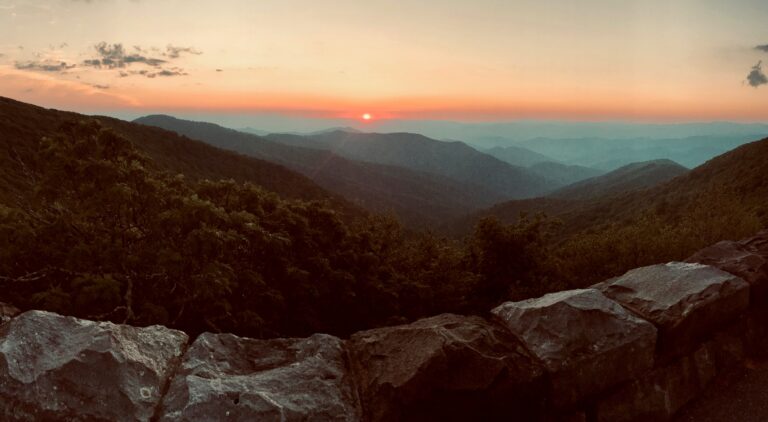
By EC Policy Manager Emma Heins
The Electrification Coalition (EC) aims to achieve mass adoption of electric vehicles (EVs) to protect U.S. national security and reduce dependence on oil in the transportation sector. The EV transition will also reduce carbon emissions, protecting America’s greatest natural treasures—our national parks and public lands—from the impacts of climate change. From April 22 to 30, the EC joins the U.S. Department of the Interior and all Americans in celebrating National Park Week and all the recreation and beauty our public lands offer.
Access to EV charging in national parks has expanded in recent years thanks to private and public groups like Adopt a Charger, Rivian, and BMW, which have donated chargers to parks. But there is still unmet demand, especially in smaller parks, to support widespread EV adoption. Given that many national parks are far from urban centers with more charging, traveling to parks can present a challenge to EV drivers.
NEVI Program
The National Electric Vehicle Infrastructure (NEVI) program is a great start to connecting EV-driving Americans with national parks. It will create a comprehensive highway charging system along alternative fuel corridors in all 50 states. NEVI will help fill existing gaps in charging infrastructure to ensure Americans can travel across the country in their EVs.
Incentivizing EV drivers to visit national parks is a win-win for both EV drivers and other visitors. Many of the most popular national parks, like Yellowstone, the Great Smoky Mountains, and the Grand Canyon, have millions of visitors yearly. With that traffic comes air pollution. Since 1948, average visibility in the Great Smoky Mountain National Park has decreased by 40% in winter and 80% in summer because of increasing levels of pollutants like ozone, PM2.5, and NOX, all produced by burning fossil fuels. Added capacity for EV charging will attract vehicles with zero tailpipe emissions to parks, which can lead to cleaner and quieter visits.

Medium- and Heavy-Duty Vehicles
But transportation electrification in national parks means more than just electrified individual, light-duty vehicles driving through the parks. An electrified National Parks System includes access to EV charging infrastructure – both for the light-duty EVs but also for electric buses and shuttles often deployed in some of the most popular parks to reduce traffic congestion. In addition, large private tour buses should also be encouraged to go electric as they are some of the dirtiest polluters, and parks should provide dedicated charging stations for tour bus operators to help enable the transition.
Transportation electrification is already on its way to parks, given the White House Executive Order 14057, which requires 100% zero-emission vehicle (ZEV) acquisition by 2035 and light-duty acquisition by 2027. This will include fleet service vehicles in parks and all-terrain park ranger vehicles. The National Parks Service fleet can reduce thousands of tons of CO2 emission, NOX, and particulate matter pollution that disrupts the peace of our protected lands while loosening the grip of oil on the American economy. Zion National Park is leading this charge in the parks system, announcing in February that with the assistance of a Department of Transportation grant, it is replacing its entire fleet of 26 shuttle buses with EVs and adding 27 charging stations. Yosemite National Park also made history in 2017 when it added two all-electric buses to the permanent fleet. As larger parks begin implementing zero-emission vehicles and charging infrastructure, smaller parks can adopt best practices and make the transition more efficient.
The federal government must take this opportunity while it is revolutionizing its internal infrastructure to invest in the parks system and expand EV charging for visitors. These actions will set an example for millions of Americans coming to enjoy our treasured lands.
Gateway Communities
Gateway communities, or towns located just outside tourist attractions like national parks, can capitalize on these efforts by installing charging in the areas that surround parks. Recent federal investments from the Bipartisan Infrastructure Law (BIL) and Inflation Reduction Act are dedicated specifically to rural charging, and gateway towns should take advantage of these once-in-a-generation funding streams. The BIL will support President Biden’s Justice40 initiative, which establishes the goal that at least 40% of the benefits of federal investments in climate and clean energy infrastructure be distributed to disadvantaged communities, including those in rural areas. Gateway towns benefit from added charging capacity because it creates more jobs for residents and encourages tourists to invest in local businesses while charging. Rather than stopping at a gas station for 5 to 10 minutes, travelers can stop at charging stations for 45 minutes and get a meal, shop at a local business, or see the sights.
Our Efforts
On April 20, to kick off our week of celebration, we hosted a special installment of our infrastructure webinar series titled “Championing Charging on Public Lands: A National Park Week Celebration“. The EC is ready to help states and communities maximize this opportunity to accelerate transportation electrification through the effective, efficient, and equitable deployment of federal funding. To get plugged into our resources, check out our National Park Week Hub.
